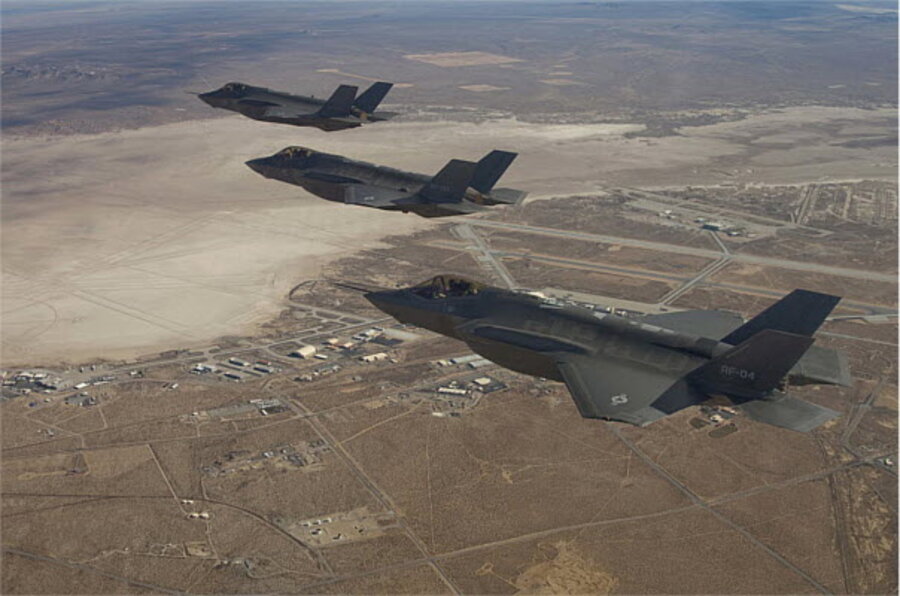F-35 Strike Fighter: Is a deal for 71 fighter jets imminent?
Loading...
| WASHINGTON
F-35 fighter jets – two batches of them – headline a deal between Lockheed Martin Corp. and the Pentagon that is making "good progress" toward agreement, said Lockheed's Chief Executive Marillyn Hewson on Tuesday.
Lockheed is building three models of the F-35 for the U.S. military and eight international partner countries: Britain, Australia, Canada, Norway, Turkey, Italy, Denmark and the Netherlands. Israel and Japan have also ordered the jet.
After protracted and difficult discussions on the previous order of F-35 jets, Pentagon officials had hoped to reach agreement with Lockheed around mid-year on the sixth and seventh orders, valued at multiple billions of dollars.
Air Force Lieutentant General Christopher Bogdan told company officials he wanted to reach agreement on the contracts by the end of July, according to industry sources. It may take some time afterward to finalize and sign the agreements.
The total number of jets involved is 71, with 36 planes to be purchased in the sixth production lot, and 35 in the seventh, said Joe DellaVedova, spokesman for the Pentagon's F-35 office. He said that number includes 60 F-35s for the U.S. military, and 11 for Australia, Italy, Turkey and Britain.
"We've been very open and transparent with our data and I think the negotiations are going well," Hewson told reporters after the company reported higher-than-expected second-quarter earnings.
"We've making good progress and we hope that we'll be able to close in the near term," she said, also citing strong Pentagon and international support for the F-35 program, despite U.S. budget cuts.
She told analysts the program racked up some big accomplishments in the second quarter, including completion of high-angle attack testing, and forecasts by the military services for when they will start using the new jets.
"You can feel the momentum accelerating throughout the program," she said, adding that Lockheed delivered 12 jets in the second quarter and expected to deliver 36 in the full year.
Chief Financial Officer Bruce Tanner told analysts the F-35 program accounted for about 15 percent of Lockheed's revenues, and that percentage would grow in coming years.
He said the two F-35 production deals would add $4.5 billion to $5 billion to the company's order books when they were completed, a move he said he expected in the third quarter. That amount comes on top of long-lead funding Lockheed has already received for the jets.
DellaVedova declined to predict when an agreement could be reached but said the two sides were making progress. The F-35 is the Pentagon's biggest weapons program, and officials have been pushing for lower prices to ensure the program's future given mounting budget pressures and mandatory budget cuts that could cut the Pentagon's budget by $500 billion over the next decade.
Tanner told analysts that Lockheed adjusted downward its second-quarter results by $85 million to reflect lower expected incentive fees on the remainder of the F-35 development contract. It made a similar adjustment last year.
Tanner said the adjustment was "a little tougher maybe than what we were thinking" but the company was earning higher single digit margins on the F-35 production contracts, and should get into double digit profits when the program gets to full productions in coming years.
The Pentagon reached agreement with Lockheed on the fifth batch of F-35s last December, agreeing to buy 32 of the advanced warplanes for $3.8 billion.
The U.S. government is negotiating separately with United Technologies Corp unit Pratt & Whitney to buy engines for the sixth batch of jets. Pratt's CEO Dave Hess told Reuters in June he expected a deal within the next 30 days.
A Pratt & Whitney spokesman had no immediate comment.
(Editing by Gerald E. McCormick, Sofina Mirza-Reid and David Gregorio)







